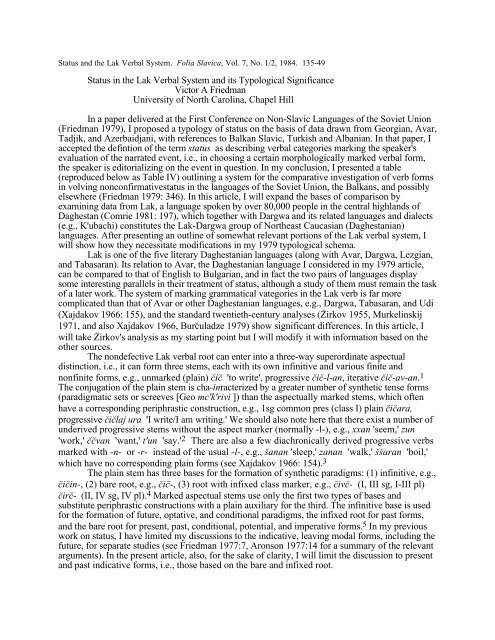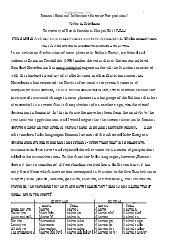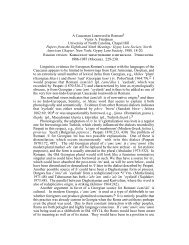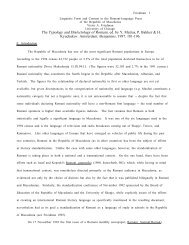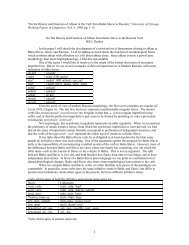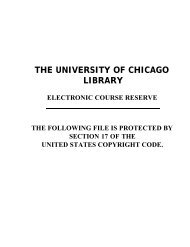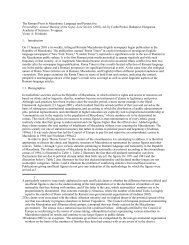Status and the Lak Verbal System - University of Chicago
Status and the Lak Verbal System - University of Chicago
Status and the Lak Verbal System - University of Chicago
- No tags were found...
Create successful ePaper yourself
Turn your PDF publications into a flip-book with our unique Google optimized e-Paper software.
<strong>Status</strong> <strong>and</strong> <strong>the</strong> <strong>Lak</strong> <strong>Verbal</strong> <strong>System</strong>. Folia Slavica, Vol. 7, No. 1/2, 1984. 135-49<strong>Status</strong> in <strong>the</strong> <strong>Lak</strong> <strong>Verbal</strong> <strong>System</strong> <strong>and</strong> its Typological SignificanceVictor A Friedman<strong>University</strong> <strong>of</strong> North Carolina, Chapel HillIn a paper delivered at <strong>the</strong> First Conference on Non-Slavic Languages <strong>of</strong> <strong>the</strong> Soviet Union(Friedman 1979), I proposed a typology <strong>of</strong> status on <strong>the</strong> basis <strong>of</strong> data drawn from Georgian, Avar,Tadjik, <strong>and</strong> Azerbaidjani, with references to Balkan Slavic, Turkish <strong>and</strong> Albanian. In that paper, Iaccepted <strong>the</strong> defintion <strong>of</strong> <strong>the</strong> term status as describing verbal categories marking <strong>the</strong> speaker'sevaluation <strong>of</strong> <strong>the</strong> narrated event, i.e., in choosing a certain morphologically marked verbal form,<strong>the</strong> speaker is editorializing on <strong>the</strong> event in question. In my conclusion, I presented a table(reproduced below as Table IV) outlining a system for <strong>the</strong> comparative investigation <strong>of</strong> verb formsin volving nonconfirmativestatus in <strong>the</strong> languages <strong>of</strong> <strong>the</strong> Soviet Union, <strong>the</strong> Balkans, <strong>and</strong> possiblyelsewhere (Friedman 1979: 346). In this article, I will exp<strong>and</strong> <strong>the</strong> bases <strong>of</strong> comparison byexamining data from <strong>Lak</strong>, a language spoken by over 80,000 people in <strong>the</strong> central highl<strong>and</strong>s <strong>of</strong>Daghestan (Comrie 1981: 197), which toge<strong>the</strong>r with Dargwa <strong>and</strong> its related languages <strong>and</strong> dialects(e.g., K'ubachi) constitutes <strong>the</strong> <strong>Lak</strong>-Dargwa group <strong>of</strong> Nor<strong>the</strong>ast Caucasian (Daghestanian)languages. After presenting an outline <strong>of</strong> somewhat relevant portions <strong>of</strong> <strong>the</strong> <strong>Lak</strong> verbal system, Iwill show how <strong>the</strong>y necessitate modifications in my 1979 typological schema.<strong>Lak</strong> is one <strong>of</strong> <strong>the</strong> five literary Daghestanian languages (along with Avar, Dargwa, Lezgian,<strong>and</strong> Tabasaran). Its relation to Avar, <strong>the</strong> Daghestanian language I considered in my 1979 article,can be compared to that <strong>of</strong> English to Bulgarian, <strong>and</strong> in fact <strong>the</strong> two pairs <strong>of</strong> languages displaysome interesting parallels in <strong>the</strong>ir treatment <strong>of</strong> status, although a study <strong>of</strong> <strong>the</strong>m must remain <strong>the</strong> task<strong>of</strong> a later work. The system <strong>of</strong> marking grammatical vategories in <strong>the</strong> <strong>Lak</strong> verb is far morecomplicated than that <strong>of</strong> Avar or o<strong>the</strong>r Daghestanian languages, e.g., Dargwa, Tabasaran, <strong>and</strong> Udi(Xajdakov 1966: 155), <strong>and</strong> <strong>the</strong> st<strong>and</strong>ard twentieth-century analyses (Z‹irkov 1955, Murkelinskij1971, <strong>and</strong> also Xajdakov 1966, Burc#uladze 1979) show significant differences. In this article, Iwill take Z‹irkov's analysis as my starting point but I will modify it with information based on <strong>the</strong>o<strong>the</strong>r sources.The nondefective <strong>Lak</strong> verbal root can enter into a three-way superordinate aspectualdistinction, i.e., it can form three stems, each with its own infinitive <strong>and</strong> various finite <strong>and</strong>nonfinite forms, e.g., unmarked (plain) c#ic# 'to write', progressive c#ic#-l-an, iterative c#ic#-av-an. 1The conjugation <strong>of</strong> <strong>the</strong> plain stem is cha-inracterized by a greater number <strong>of</strong> syn<strong>the</strong>tic tense forms(paradigmatic sets or screeves [Geo mc'k'rivi ]) than <strong>the</strong> aspectually marked stems, which <strong>of</strong>tenhave a corresponding periphrastic construction, e.g., 1sg common pres (class I) plain c#ic#ara,progressive c#ic#laj ura 'I write/I am writing.' We should also note here that <strong>the</strong>re exist a number <strong>of</strong>underived progressive stems without <strong>the</strong> aspect marker (normally -l-), e.g., xxan 'seem,' zun'work,' c#c#van 'want,' t'un 'say.' 2 There are also a few diachronically derived progressive verbsmarked with -n- or -r- instead <strong>of</strong> <strong>the</strong> usual -l-, e.g., s#anan 'sleep,' zanan 'walk,' s#s#aran 'boil,'which have no corresponding plain forms (see Xajdakov 1966: 154). 3The plain stem has three bases for <strong>the</strong> formation <strong>of</strong> syn<strong>the</strong>tic paradigms: (1) infinitive, e.g.,c#ic#in-, (2) bare root, e.g., c#ic#-, (3) root with infixed class marker, e.g., c#ivc#- (I, III sg, I-III pl)c#irc#- (II, IV sg, IV pl). 4 Marked aspectual stems use only <strong>the</strong> first two types <strong>of</strong> bases <strong>and</strong>substitute periphrastic constructions with a plain auxiliary for <strong>the</strong> third. The infinitive base is usedfor <strong>the</strong> formation <strong>of</strong> future, optative, <strong>and</strong> conditional paradigms, <strong>the</strong> infixed root for past forms,<strong>and</strong> <strong>the</strong> bare root for present, past, conditional, potential, <strong>and</strong> imperative forms. 5 In my previouswork on status, I have limited my discussions to <strong>the</strong> indicative, leaving modal forms, including <strong>the</strong>future, for separate studies (see Friedman 1977:7, Aronson 1977:14 for a summary <strong>of</strong> <strong>the</strong> relevantarguments). In <strong>the</strong> present article, also, for <strong>the</strong> sake <strong>of</strong> clarity, I will limit <strong>the</strong> discussion to present<strong>and</strong> past indicative forms, i.e., those based on <strong>the</strong> bare <strong>and</strong> infixed root.
A number <strong>of</strong> <strong>the</strong> languages that I studied in my earlier work have past tense forms whichare marked for <strong>the</strong> speaker's personal confirmation <strong>of</strong> thr truth <strong>of</strong> <strong>the</strong> narrated event. In <strong>Lak</strong>,however, <strong>the</strong>re is a morphologically marked confirmative (Russ utverditel'nyj, Geo mt'k'icebiti )in both <strong>the</strong> past <strong>and</strong> <strong>the</strong> non-past. 6 The meaning <strong>of</strong> <strong>the</strong> present confirmative can be compared to <strong>the</strong>English assertive in do, e.g., I do believe in ghosts! (cf. Burc#uladze 1979: 244). Un like <strong>the</strong>English assertive, however, <strong>the</strong> <strong>Lak</strong> confirmative, which is based on <strong>the</strong> adjectival suffix -ssa, canbe marked in both syn<strong>the</strong>tic forms, <strong>and</strong>, by means <strong>of</strong> an auxiliary, in analytic forms in a widevarity <strong>of</strong> tenses <strong>and</strong> moods, where English must rely on stress <strong>and</strong> intonation. Consider <strong>the</strong>following examples from Burc#uladze (1979: 188, 193) <strong>and</strong> Murkelinskij (1971: 176) :(1) Na c#ic#ara c#ag#ar (common plain pres) 'I write a letter'(2) Na c#ic#ajssar c#ag#ar (conf plain pres) 'I do write a letter' 7(3) Na c#ic#laj ura c#ag#ar (common prog pres) 'I am writing a letter'(4) Na c#ic#lac#issara c#ag#ar (conf prog pres) 'I am writing a letter' 8(5) Ta ur tikku (common plain pres) 'He's <strong>the</strong>re'(6) Ta ussar tikku (conf plain pres) 'He is <strong>the</strong>re'The <strong>Lak</strong> confirmative also has a wider range <strong>of</strong> co-occurrence possibilities syntactically aswell as paradigmatically, but this requires fur<strong>the</strong>r investigation. 9The <strong>Lak</strong> preterite system is characterized by a rich variety <strong>of</strong> syn<strong>the</strong>tic <strong>and</strong> analytic tenseforms. In addition to problems caused by inconsistencies in <strong>the</strong> inventory <strong>and</strong> nomenclature usedin various descriptions (cf., e.g., Xajdakov 1975:156 <strong>and</strong> N=Murkelinskij 1971:201, where <strong>the</strong>same tense form is labeled imperfect <strong>and</strong> pluperfect, respectively; cf. also Burc#uladze 1979:195,198-99) <strong>and</strong> by questions <strong>of</strong> agreement with subject <strong>and</strong> objects, <strong>the</strong> <strong>Lak</strong> preterite sysytem iscomplicated by a phenomenon labeled by Xajdakov (1975:155) heterogeneous paradigms. From amore or less diachronic point <strong>of</strong> view, <strong>Lak</strong> can be said to have one defective <strong>and</strong> seven completesyn<strong>the</strong>tic indicative past tense forms: <strong>the</strong> perfect or confrirmative perfect, with only first personforms, <strong>the</strong> aorist, archaic past, confirmative archaic past, imperfect, confirmative imperfect,pluperfect, <strong>and</strong> confirmative pluperfect. 10 From a synchronic viewpoint, however, <strong>the</strong>re are fewersets <strong>of</strong> paradigms: aorist, confirmative archaic past, imperfect, <strong>and</strong> pluperfect. The perfect, aorist,<strong>and</strong> archaic past combine to form a single aorist paradigm - <strong>the</strong> source <strong>of</strong> any given form beingdetermined by person <strong>and</strong> voice - while <strong>the</strong> synchronic imperfect <strong>and</strong> pluperfect can both combineforms from <strong>the</strong>ir respective common <strong>and</strong> confirmative paradigms. Table I gives examples <strong>of</strong> <strong>the</strong>preterite paradigms in diachronic terms using <strong>the</strong> verb 'write.' 11 Table II presents <strong>the</strong> sources <strong>of</strong><strong>the</strong> synchronic heterogenous paradigms.Table IIMPERFECT PLUPERFECT ARCHAICcommon c#ic#ajva (v) c#ivc#una (v) c#ivc#ur -a -u -øconf c#ic#ajssija (v) c#ivc#ussija (v) c#ivc#ussar -a -u -øPERFECTAORISTc#ic#av c#ic#ardu c#ivc#unn -a -u -iNote: The (v) <strong>of</strong> <strong>the</strong> imperfect <strong>and</strong> pluperfect forms is added to mark <strong>the</strong> first <strong>and</strong> secondpersons. The -a -u -ø/-i <strong>of</strong> <strong>the</strong> archaic <strong>and</strong> aorist forms mark <strong>the</strong> first & second singular, first <strong>and</strong>second plural, <strong>and</strong> third persons, respectively. 12 The perfect has only first singular <strong>and</strong> first pluralforms.Table IIAORIST 'Write' 'Go'Transitive Intransitive singular/plural singular/plural1 perfect archaic 13 c#ic#av/c#ic#ardu lavgra/lavgru2 aorist c#ivc#unna/c#ivc#unnu lavgunna/lavgunnu
Apparently <strong>the</strong>re is no better medicine than <strong>the</strong> marrow <strong>of</strong> a wolf's shin-bone.(22) G‹aral lac#laj dussa dur (Murkelinskij 1971:198)It's raining, apparently.(23) G‹aral lac#'laj dir'kun dur (Murkelinskij 1971:205)It was raining (it turns out).(24) Qami zij birk'un bussa bur (Murkelinskij 1971:196)The women had been working (it turns out).(25) Tanil culk'lux ' c'uvxxunu bur (Z‹irkov 1955:141)She [<strong>the</strong> wolf III] asked <strong>the</strong> fox:(26a) Ömar qin x'unu ussa ur (Murkelinskij 1971:205)Omar has gotten well, it turns out.(26b) Ta äjq˙unu ussa ur (Murkelinskij 1971:205)He has made a mistake, it turns out.(27) Ta lavgun ivk'un ur (Murkelinskij 1971:205)He had left, it turns out.(28) C'an x'unu dirk'un dussa dur (Murkelinskij 1971:196)It had gotten dark, it turms out.Even from <strong>the</strong> abbreviated outline <strong>of</strong> part <strong>of</strong> <strong>the</strong> <strong>Lak</strong> verbal system given here, it can beseen that <strong>the</strong> status oppositions <strong>of</strong> <strong>Lak</strong> display significant differences from those <strong>of</strong> <strong>the</strong> languages Ihave considered in my earlier work. Starting with <strong>the</strong> concluding outline alluded to earlier(Friedman 1979:346) <strong>and</strong> reproduced here as Table IV, it is possible to make a number <strong>of</strong>meaningful comparisons <strong>and</strong> modifications. In doing so, I will follow <strong>the</strong> numbering system givenin Table IV.Table IVI. Perfect as pure resultative vs Perfect as nonconfirmativeA. First PersonB. Connected narratives1. With definite past time adverbs2. In folk talesII. Perfect with apparently nonpast meaningsA. Resultative1. Admirative2. Stative3. Performative4. O<strong>the</strong>r emotiveB. Nonconfirmative1. DubitativeIII. Quotative particlesA. CliticB. IndependentIV. Competing formsA. ResultativeB. NonconfirmativeV. Relation <strong>of</strong> perfect to neighboring formsA. Simple preterite1. Marked confirmative2. Unmarked3. O<strong>the</strong>rB. Pluperfect1. Pure reported
1. Marked confirmative2. Unmarked3. O<strong>the</strong>rB. Pluperfect1. Pure reported2. Pure taxic3. Marked confirmative4. ModalC. Nonpreterite (present)1. Unmarked2. Confirmative3. NonconfirmativeVI. Influence <strong>of</strong> o<strong>the</strong>r generic categoriesA. AspectB. VoiceVII. Volition, Uncertainty, InterrogationVIII. Syn<strong>the</strong>tic va Analytic construction(IX. Modality)REFERENCESAronson, Howard I. 1977. "Interrelationships between Aspect <strong>and</strong> Mood in Bulgarian," FoliaSlavica 1:9-32.Burc#uladze, G. T. 1979. "Voprosy stanovlenija lic#nogo sprjaz#enija v lakskom jazyke," Iberiulk'avk'asiurienatmecnierebis c'elic'deuli 6:176-246.Comrie, Bernard. 1981. The Languages <strong>of</strong> <strong>the</strong> Soviet Union. Cambridge: Cambridge.Friedman, Victor A. 1977. The Grammatical Categories <strong>of</strong> <strong>the</strong> Macedonian Indicative.Columbus: Slavica.________. 1979. "Toward a Typology <strong>of</strong> <strong>Status</strong>: Georgian <strong>and</strong> O<strong>the</strong>r Non-Slavic Languages <strong>of</strong><strong>the</strong>Soviet Union," in The Elements ; Paul R. Clyne et al., eds. <strong>Chicago</strong>: <strong>Chicago</strong> LinguisticSociety, 339-350.Gvarj≠alaje, I. <strong>and</strong> M. Kursras#vili. 1973. Inglisuri <strong>and</strong>azebi da xat'ovani tkmani. Tbilisi:Mecniereba.Murkelinskij, G. B. 1967. "<strong>Lak</strong>skij jazyk," in Jazyki narodov SSSR: IV. Iberijsko-kavkazskiejazyki; E.A. Bokarev, ed. Moscow: Nauka, 488-507.________. 1971. Grammatika lakskogo jazyka: I. Fonetika i morfologija. Maxac#kala:Dagestanskoe uc#ebno-pedagogic#eskoe izdatel'stvo.Xajdakov, S. M. 1961. Oc#erki po leksike lakskogo jazyka. Moscow: Akademija nauk SSSR.________. 1966. Oc#erki po lakskoj dialektologii. Moscow: Nauka.________. 1975. Sistema glagola v dagestanskix jazykov. Moscow: Nauka.Xalilov, Xalil. 1969. <strong>Lak</strong>ral laqi balajrdu-<strong>Lak</strong>skie epic#eskie pesni. Maxac#kala: Akademija naukSSSR.Z‹irkov, L. I. 1955. <strong>Lak</strong>skij jazyk. Moscow: Akademija Nauk SSSR.I wish to thank <strong>the</strong> <strong>University</strong> <strong>of</strong> North Carolina Research Council for a grant which aided me in <strong>the</strong> researchnecessary for this article. I also wish to thank <strong>the</strong> Library <strong>of</strong> <strong>the</strong> Academy <strong>of</strong> Sciences <strong>of</strong> <strong>the</strong> Georgian SSR forregularly sending me materials essential to this work. Most <strong>of</strong> all, I wish to thank my <strong>Lak</strong> informant, Ms ElenoraMagomedova. Ms Magomedova was raised in <strong>the</strong> aul <strong>of</strong> Kaja (C‹äjmi) but educated in <strong>the</strong> literary dialect, viz. Xumux(G‹umuc#i).1 The orthography used in this article follows current <strong>Lak</strong> orthographic practice in using doubled consonants for <strong>the</strong>pharyngealized stops, affricates, <strong>and</strong> fricatives (but h' for <strong>the</strong> glottalic pharyngealized fricative), v for [v] <strong>and</strong> [w],<strong>and</strong> no marks for length/stress. Glottalization is indicated by a subscript or superscript dot, <strong>the</strong> uvular series arerepresented by q <strong>and</strong> x , <strong>the</strong> velar series by k <strong>and</strong> x £. The diaresis is used for front vowels (pharyngealized ininital position).
2 The plain infinitive <strong>of</strong> 'say' is uc#in, past gerund uvkunu (I).3 The iterative aspect has <strong>the</strong> smallest number <strong>of</strong> syn<strong>the</strong>tic tense forms <strong>and</strong> presents virtually no irregularities. As itdoes not present any unique peculiarities germane to <strong>the</strong> discussion <strong>of</strong> status in this article, <strong>the</strong> remainder <strong>of</strong> <strong>the</strong>discussion will be limited to <strong>the</strong> plain <strong>and</strong> progressive aspects (cf. Xajdakov 1966:154, Z‹irkov 1955:95-100).4 Some verbs also take prefixed class markers: ø (I sg), b- (III sg, I-III pl), d- (II, IV sg. IV pl). Such verbs will bepreceded by a hyphen when being cited, e.g., -ur 'is' implies <strong>the</strong> forms ur, bur, dur, ura, bura, dura, buru, durudepending on <strong>the</strong> class, number, <strong>and</strong> person <strong>of</strong> <strong>the</strong> referent (subject or object)5 There are, in addition, a large number <strong>of</strong> participial <strong>and</strong> gerundive forms which can be derived from <strong>the</strong>se threebases. The complete details are beyond <strong>the</strong> scope <strong>of</strong> this article (see Z‹irkov 1955:95-99, Murkelinskij 1971:218-232).6 The English term affirmative is used by Burc#uladze (1979:244), but I have eschewed it in <strong>the</strong> context <strong>of</strong> thisarticle due to its possible confusion with affirmative in <strong>the</strong> meaning <strong>of</strong> 'non-negative declarative'.7 For complex historical reasons, <strong>the</strong> plain confirmative transitive present agrees with <strong>the</strong> object, while <strong>the</strong>progressive, like <strong>the</strong> plain common present, agrees with <strong>the</strong> subject (see Burc#uladze 1979:188-93).8 The progressive has reduplication <strong>of</strong> <strong>the</strong> second root consonant in confirmative <strong>and</strong> some partcipial forms based on<strong>the</strong> root.9 One noteworthy example <strong>of</strong> <strong>the</strong> use <strong>of</strong> <strong>the</strong> <strong>Lak</strong> confirmative occurs in proverbs (Xajdakov 1961:116). In contrastto, e.g., Georgian, which ordinarily suffixes <strong>the</strong> quotative particle-o to proverbs, <strong>Lak</strong> ordinarily uses <strong>the</strong>confirmative, as can be seen form <strong>the</strong> following example:(i) Kä' valin lavgunni kunu lac#c#ul c#ismus nac'u x £unu qqabuc#'ajssar (Xajdakov 1961:116)Having gone to <strong>the</strong> Kaaba, garlic does not come back sweet.Cf. Geo Ierusalims niori gagzavnes, dabrunda da isev q˙ardao (Gvarj≠alaje <strong>and</strong> Kuasvili 1976;173)They sent <strong>the</strong> garlic to Jerusalem it came back <strong>and</strong> still stank.It is interesting to note that in <strong>the</strong> languages <strong>of</strong> <strong>the</strong> Balkans with marked confirmative status categories, it isgenerally <strong>the</strong> unmarked verb form (Macedonian <strong>and</strong> Bulgarian -l, Turkish -mis∞ ) which is generally used inproverbs, although <strong>the</strong> complete picture is much more complex. (Thus, for example, while Georgian usually uses<strong>the</strong> aorist, it will use <strong>the</strong> perfect in sayings which involve talking animals or inanimate abjects, whereas Turkishwill use <strong>the</strong> confirmative past (-di ) in certain types <strong>of</strong> gnomic proverbs.)10 The nomenclature here follows that <strong>of</strong> Burc#uladze (1979), which is <strong>the</strong> most consistent <strong>and</strong> takes all <strong>the</strong> previousliterature into account.11 Some authors include <strong>the</strong> iterative imperfect <strong>of</strong> <strong>the</strong> type c#ic#avard- -a, -u, -i in <strong>the</strong>ir general accounts <strong>of</strong> <strong>the</strong> <strong>Lak</strong>system, but <strong>the</strong>se forms are not germane to <strong>the</strong> discussion here (see Burc#uladze 1979:198-99, also Xajdakov1966:166, 1975:155, 167).12 The rules for <strong>the</strong> choice <strong>of</strong> referent for person-number-class marking are beyond <strong>the</strong> scope <strong>of</strong> this paper. Verbswith infinitives in -an, -un have <strong>the</strong> third person marker -i in <strong>the</strong> common archaic past as well as in <strong>the</strong> aorist.13 The second <strong>and</strong> third person forms <strong>of</strong> <strong>the</strong> archaic past are in fact archaic. They occur primarily in folk tales <strong>and</strong>epics (Burc#uladze 1979:203).14 According to Z‹irkov (1955:108), t'ar is <strong>the</strong> third present <strong>of</strong> t'un but does not occur in <strong>the</strong> speech <strong>of</strong> Kumux. Theuse <strong>of</strong> uc#in/t'un is additionally complicated by <strong>the</strong> fact that it is used to form compound verbs, e.g., t'urku t'un 'toplay,' as well as in a variety <strong>of</strong> syntactic <strong>and</strong> even grammatical constructions (see Z‹irkov 1955:108-109).15 Table III is liimited to constructions witha present participle, present gerund, or past gerund. O<strong>the</strong>r possibilitiesinclude <strong>the</strong> durative progressive present participle, e.g.:(ii) G‹aral lac#'lajnna dussa dur (Murkelinskij 1971:195)Apparently it keeps raining.16 In this, <strong>Lak</strong> behaves like Turkish, which uses <strong>the</strong> perfect-in-origin mis∞- past, ra<strong>the</strong>r than like Georgian, whichuses <strong>the</strong> aorist, cf. <strong>the</strong> st<strong>and</strong>ard opening equivalent <strong>of</strong> <strong>the</strong> English Once upon a time, which translates literally'[Once] <strong>the</strong>re was, (<strong>and</strong>) <strong>the</strong>re wasn't;<strong>Lak</strong>: Atti-tti bivk'un bur, qqabivk'un burTurk: Bir varmis∞, bir yokmus∞Geo: Iq˙o da ara iq˙o17 As was noted at <strong>the</strong> beginning <strong>of</strong> this article, <strong>the</strong> <strong>Lak</strong> confirmative can be compared to <strong>the</strong> English assertive indo. However, <strong>Lak</strong> differs significantly from English not only due to <strong>the</strong> fact that <strong>the</strong> <strong>Lak</strong> confirmative can occur in a
wider variety <strong>of</strong> tense forms (syn<strong>the</strong>tic <strong>and</strong> analytic) <strong>and</strong> sentence types (affirmative, negative, interrogative), but alsobecause <strong>Lak</strong> has nonconfirmative tense forms <strong>of</strong> <strong>the</strong> type found in <strong>the</strong> Balkan-Pontic-Caspian area but not in WesternEurope.


